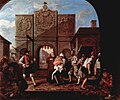Tate Britain
Jump to navigation
Jump to search
art museum on Millbank, Westminster, London, UK | |||||
| Upload media | |||||
| Instance of | |||||
|---|---|---|---|---|---|
| Part of | |||||
| Location | Millbank, City of Westminster, Greater London, London, England | ||||
| Street address |
| ||||
| Architect | |||||
| Founded by | |||||
| Heritage designation |
| ||||
| Inception |
| ||||
| Date of official opening |
| ||||
| Structure replaces | |||||
| Visitors per year |
| ||||
| official website | |||||
 | |||||
| |||||
English: Tate Britain is an art gallery situated on Millbank in London.
Building
[edit]Main category: Tate Britain (building)
-
Main entrance, Millbank
-
Clore Gallery
-
Tate Britain draped for the 2003 Tate Triennial exhibition
-
World War II bomb damage still visible on the Atterbury Street wall
Paintings
[edit](selection)
Main category: Paintings in Tate Britain
-
British School, The Cholmondeley Ladies, circa 1600
-
Sir Peter Paul Rubens, Sketch for the Banqueting House Ceiling, circa 1629
-
David Des Granges, The Saltonstall Family, circa 1636
-
Sir Anthony van Dyck, Portrait of Sir William Killigrew, 1638
-
William Dobson, Portrait of Endymion Porter, circa 1642–5
-
William Hogarth, The Painter and his Pug, 1745
-
William Hogarth, The Roast Beef of Old England, 1748
-
William Hogarth, Heads of Six of Hogarth's Servants, mid-1750s
-
George Stubbs, Mares and Foals in a River Landscape, 1763–8
-
Sir Joshua Reynolds, Colonel Acland and Lord Sydney ("The Archers"), 1769
-
Sir Joshua Reynolds, Three Ladies Adoring a Term of Hymen, 1773
-
Joseph Wright of Derby, Vesuvius in Eruption, with a View over the Islands in the Bay of Naples, 1776
-
Thomas Jones, The Capella Nuova outside the Porta di Chiaja, Naples, 1782
-
Henry Fuseli, Titania and Bottom, c. 1790
-
William Blake, Newton, 1795
-
John Constable, Flatford Mill (Scene on a Navigable River), 1816–7
-
William Blake Satan Smiting Job with Sore Boils, c. 1826
-
Joseph Mallord William Turner, Peace – Burial at Sea 1842
-
John Everett Millais, Christ in the House of His Parents (`The Carpenter's Shop'), c. 1849
-
Dante Gabriel Rossetti Ecce Ancilla Domini!, c. 1849
-
John Martin, The Great Day of His Wrath, c. 1851
-
Sir John Everett Millais, Ophelia, c. 1851
-
Sir John Everett Millais, Mariana, 1851
-
William Holman Hunt, Our English Coasts, 1852 (`Strayed Sheep')
-
William Holman Hunt, The Awakening Conscience, 1853
-
Richard Dadd, The Fairy Feller's Master-Stroke, 1855–64
-
Henry Wallis, The Death of Chatterton, 1856
-
William Dyce, Pegwell Bay, c. 1858
-
Dante Gabriel Rossetti, Beata Beatrix, c. 1864–70
-
James Abbott McNeill Whistler, Symphony in White, No. 2: The Little White Girl, 1864–5
-
James Abbott McNeill Whistler, Nocturne in Blue and Gold – Old Battersea Bridge, c. 1872–5
-
Dante Gabriel Rossetti, Proserpine, 1874
-
Edward Burne-Jones, The Golden Stairs, 1876–80
-
Edward Burne-Jones, King Cophetua and the Beggar Maid, 1884
-
John Singer Sargent, Carnation, Lily, Lily, Rose, 1885–6
-
George Frederic Watts and assistants, Hope, 1886
-
John William Waterhouse, The Lady of Shalott, 1888
-
John Singer Sargent, Ellen Terry as Lady Macbeth, 1889
-
Frederic Lord Leighton, And the Sea Gave Up the Dead Which Were in It, 1892
-
Herbert James Draper, The Lament for Icarus, 1898
-
Gwen John, Self-Portrait, 1902
-
. 1903. 41 × 33.3 cm (16.1 × 13.1 in). oil on canvas
-
Sir Lawrence Alma-Tadema, A Favourite Custom, 1909


















































